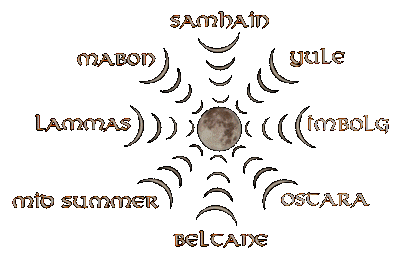
WHEEL OF THE YEAR
The eight Sabbats celebrate the cycle of life, death, and rebirth present in all
of nature.
This cycle, and the celebration thereof, is known as "turning the Wheel of
the Year."

YULE - December 21st
Also known as the Winter Solstice, this date marks the rebirth of the Sun
God. Yule is shortest day of the year. Some celebrate Yule as the
date marking the New Year, while other recognize the Celtic New Year, Samhain.
The colors of Yule are red, green, and white. Yule logs are often
decorated to represent the sun always returning to the Earth. For more
information, see the YULE page
IMBOLC - February 2nd
Also known as Candlemas, this is a day for celebrating the first stirrings of spring. The Goddess nurtures her young son, the God, and seeds are planted for all things desired. The colors of Imbolg are white and lavendar. Candle wreaths are often made, and candles are blessed for the year. For more info, see the IMBOLC page.
OSTARA - March 21st
Also known as the Spring Equinox, this is the day for fire and fertility festivals. We celebrate the return of the sun and new life. The days and nights are equal at the Spring Equinox, and the young God is growing and maturing. The colors of Ostara are white and other pastels. Many people plant gardens, color eggs as a symbol of fertility, or plant a seed for things they wish to bring into their lives that year. For more info, see the OSTARA page.
BELTANE - May 1st
This is a day to celebrate the symbolic union of the Goddess and God. Nature is fertile, and we prepare for the coming summer. The colors of Beltane are red, pink, green, and white. The Great Rite is performed to symbolize the union of the God and Goddess, balefires are lit, and maypole dancing is common. For more information, see the BELTANE page.
MIDSUMMER - June 21st
Also known as the Summer Solstice or Litha, at this time the Sun/God is at the height of its power. This is the longest day of the year, and there is great bounty in nature. This is the season between planting and harvesting. The colors of Midsummer are yellow, green, and orange. Many people make mead for Yule, or make solar crosses (also known as Bridget's Cross).
LAMMAS - August 1st
Also known as Lughnasadh, this is the celebration of the first harvest. This is the time we reap the bounty of the seeds planted in the Spring. The colors of Lammas are tan, gold, and brown. This is a good time for weaving brooms, making bread, or making corn dolls.
MABON - September 21st
Also known as the Autumn Equinox, this is the celebration of the second harvest. The days and the nights are equal again, and we prepare for the long, cold months of winter. The colors of Mabon are gold, maroon, and dark orange. Most people celebrate Mabon with a feast.
SAMHAIN - October 31st
Samhain marks the date of the Celtic New Year. It is the celebration of
the final harvest and signifies the death or retreat of the God. Samhain
is celebrated by non-pagans as Halloween, or All Hallow's Eve. At Samhain,
the veil between the physical world and the spiritual world is said to be at its
thinnest, and therefore spirits are able to pass between the two.
Those of use who reside on the physical plane are able to commune with our
ancestors at this time of year. The colors of Samhain are orange and
black. Balefires are lit, divination is performed, and the ancients are
honored.